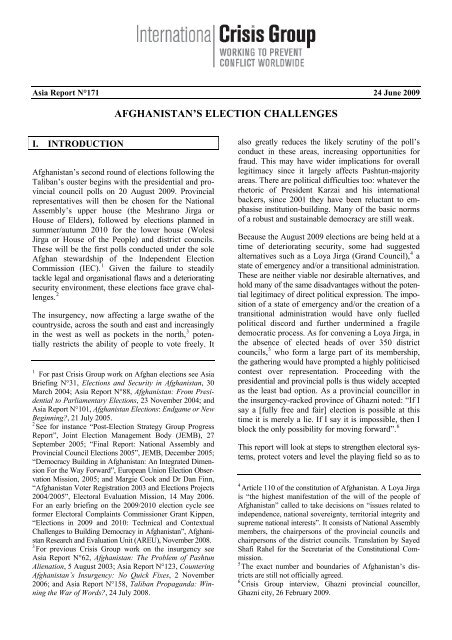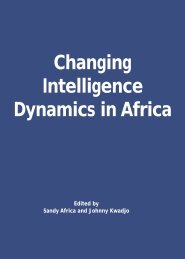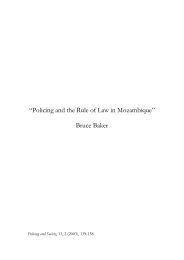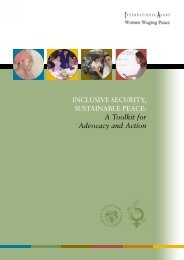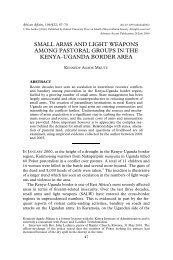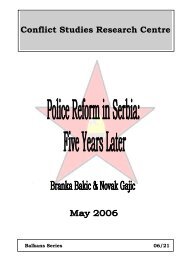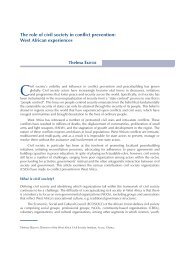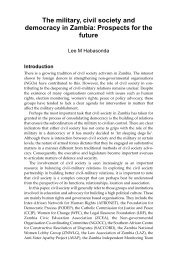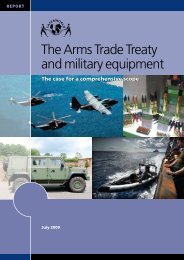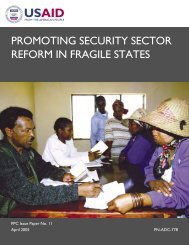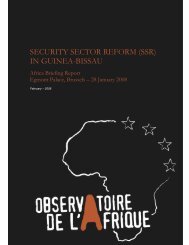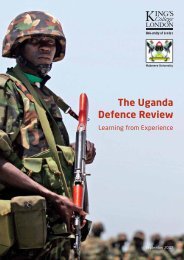AFGHANISTAN'S ELECTION CHALLENGES
AFGHANISTAN'S ELECTION CHALLENGES
AFGHANISTAN'S ELECTION CHALLENGES
Create successful ePaper yourself
Turn your PDF publications into a flip-book with our unique Google optimized e-Paper software.
Asia Report N°171 24 June 2009<br />
AFGHANISTAN’S <strong>ELECTION</strong> <strong>CHALLENGES</strong><br />
I. 0INTRODUCTION<br />
Afghanistan’s second round of elections following the<br />
Taliban’s ouster begins with the presidential and provincial<br />
council polls on 20 August 2009. Provincial<br />
representatives will then be chosen for the National<br />
Assembly’s upper house (the Meshrano Jirga or<br />
House of Elders), followed by elections planned in<br />
summer/autumn 2010 for the lower house (Wolesi<br />
Jirga or House of the People) and district councils.<br />
These will be the first polls conducted under the sole<br />
Afghan stewardship of the Independent Election<br />
Commission (IEC). 1 Given the failure to steadily<br />
tackle legal and organisational flaws and a deteriorating<br />
security environment, these elections face grave challenges.<br />
2<br />
The insurgency, now affecting a large swathe of the<br />
countryside, across the south and east and increasingly<br />
in the west as well as pockets in the north, 3 potentially<br />
restricts the ability of people to vote freely. It<br />
1 For past Crisis Group work on Afghan elections see Asia<br />
Briefing N°31, Elections and Security in Afghanistan, 30<br />
March 2004; Asia Report N°88, Afghanistan: From Presidential<br />
to Parliamentary Elections, 23 November 2004; and<br />
Asia Report N°101, Afghanistan Elections: Endgame or New<br />
Beginning?, 21 July 2005.<br />
2 See for instance “Post-Election Strategy Group Progress<br />
Report”, Joint Election Management Body (JEMB), 27<br />
September 2005; “Final Report: National Assembly and<br />
Provincial Council Elections 2005”, JEMB, December 2005;<br />
“Democracy Building in Afghanistan: An Integrated Dimension<br />
For the Way Forward”, European Union Election Observation<br />
Mission, 2005; and Margie Cook and Dr Dan Finn,<br />
“Afghanistan Voter Registration 2003 and Elections Projects<br />
2004/2005”, Electoral Evaluation Mission, 14 May 2006.<br />
For an early briefing on the 2009/2010 election cycle see<br />
former Electoral Complaints Commissioner Grant Kippen,<br />
“Elections in 2009 and 2010: Technical and Contextual<br />
Challenges to Building Democracy in Afghanistan”, Afghanistan<br />
Research and Evaluation Unit (AREU), November 2008.<br />
3 For previous Crisis Group work on the insurgency see<br />
Asia Report N°62, Afghanistan: The Problem of Pashtun<br />
Alienation, 5 August 2003; Asia Report N°123, Countering<br />
Afghanistan’s Insurgency: No Quick Fixes, 2 November<br />
2006; and Asia Report N°158, Taliban Propaganda: Winning<br />
the War of Words?, 24 July 2008.<br />
also greatly reduces the likely scrutiny of the poll’s<br />
conduct in these areas, increasing opportunities for<br />
fraud. This may have wider implications for overall<br />
legitimacy since it largely affects Pashtun-majority<br />
areas. There are political difficulties too: whatever the<br />
rhetoric of President Karzai and his international<br />
backers, since 2001 they have been reluctant to emphasise<br />
institution-building. Many of the basic norms<br />
of a robust and sustainable democracy are still weak.<br />
Because the August 2009 elections are being held at a<br />
time of deteriorating security, some had suggested<br />
alternatives such as a Loya Jirga (Grand Council), 4 a<br />
state of emergency and/or a transitional administration.<br />
These are neither viable nor desirable alternatives, and<br />
hold many of the same disadvantages without the potential<br />
legitimacy of direct political expression. The imposition<br />
of a state of emergency and/or the creation of a<br />
transitional administration would have only fuelled<br />
political discord and further undermined a fragile<br />
democratic process. As for convening a Loya Jirga, in<br />
the absence of elected heads of over 350 district<br />
councils, 5 who form a large part of its membership,<br />
the gathering would have prompted a highly politicised<br />
contest over representation. Proceeding with the<br />
presidential and provincial polls is thus widely accepted<br />
as the least bad option. As a provincial councillor in<br />
the insurgency-racked province of Ghazni noted: “If I<br />
say a [fully free and fair] election is possible at this<br />
time it is merely a lie. If I say it is impossible, then I<br />
block the only possibility for moving forward”. 6<br />
This report will look at steps to strengthen electoral systems,<br />
protect voters and level the playing field so as to<br />
4 Article 110 of the constitution of Afghanistan. A Loya Jirga<br />
is “the highest manifestation of the will of the people of<br />
Afghanistan” called to take decisions on “issues related to<br />
independence, national sovereignty, territorial integrity and<br />
supreme national interests”. It consists of National Assembly<br />
members, the chairpersons of the provincial councils and<br />
chairpersons of the district councils. Translation by Sayed<br />
Shafi Rahel for the Secretariat of the Constitutional Commission.<br />
5 The exact number and boundaries of Afghanistan’s districts<br />
are still not officially agreed.<br />
6 Crisis Group interview, Ghazni provincial councillor,<br />
Ghazni city, 26 February 2009.


